
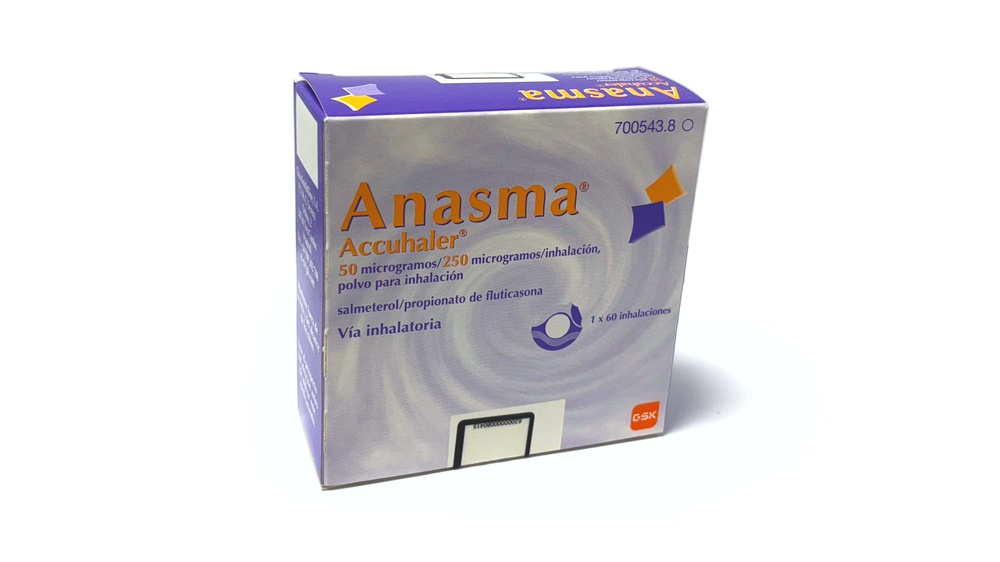
ANASMA ACCUHALER 50 micrograms/250 micrograms INHALATION, POWDER FOR INHALATION

Ask a doctor about a prescription for ANASMA ACCUHALER 50 micrograms/250 micrograms INHALATION, POWDER FOR INHALATION

How to use ANASMA ACCUHALER 50 micrograms/250 micrograms INHALATION, POWDER FOR INHALATION
Introduction
Package Leaflet: Information for the User
Anasma Accuhaler 50 micrograms/250 micrograms/inhalation, powder for inhalation
salmeterol/fluticasone propionate
Read all of this leaflet carefully before you start using this medicine because it contains important information for you.
- Keep this leaflet, you may need to read it again.
- If you have any further questions, ask your doctor or pharmacist.
- This medicine has been prescribed for you only. Do not pass it on to others. It may harm them, even if their signs of illness are the same as yours.
- If you get any side effects, talk to your doctor or pharmacist. This includes any possible side effects not listed in this leaflet. See section 4.
Contents of the pack and other information
- What is Anasma and what is it used for
- What you need to know before you use Anasma
- How to use Anasma
- Possible side effects
- Storing Anasma
- Contents of the pack and further information
1. What is Anasma and what is it used for
Anasma contains two active substances, salmeterol and fluticasone propionate:
- Salmeterol is a long-acting bronchodilator. Bronchodilators help to keep the airways in the lungs open, making it easier to breathe in and out. The effects last for at least 12 hours.
- Fluticasone propionate is a corticosteroid that reduces inflammation and irritation in the lungs.
Your doctor has prescribed this medicine to help prevent breathing problems such as:
- Asthma.
- Chronic Obstructive Pulmonary Disease (COPD). Anasma Accuhaler, in a dose of 50/500 micrograms, reduces the number of exacerbations of COPD symptoms.
You should use Anasma every day, as your doctor has recommended. This will ensure that the medication works correctly to control your asthma or COPD.
Anasma helps to prevent shortness of breath and wheezing. However, Anasma should not be used to relieve a sudden attack of shortness of breath or wheezing. In such cases, you should use your fast-acting "rescue" medication, such as salbutamol. You should always carry your fast-acting "rescue" medication with you.
2. What you need to know before you use Anasma
Do not use Anasma
- if you are allergic to salmeterol, fluticasone propionate or to the other ingredient, lactose monohydrate.
Warnings and precautions
Talk to your doctor before starting treatment if you have:
- Heart problems, including fast or irregular heartbeat.
- Overactive thyroid gland.
- High blood pressure.
- Diabetes mellitus (Anasma may increase blood sugar levels).
- Low potassium levels in the blood.
- Tuberculosis (TB) now or in the past or other lung infections.
Contact your doctor if you experience blurred vision or other visual disturbances.
Using Anasma with other medicines
Tell your doctor or pharmacist if you are using, have recently used or might use any other medicines, including those for asthma or those bought without a prescription. The reason is that, in some cases, Anasma should not be taken with other medicines.
Tell your doctor if you are taking any of the following medicines before you start using Anasma:
- Beta-blockers (such as atenolol, propranolol, and sotalol). Beta-blockers are mainly used to treat high blood pressure or other heart conditions.
- Medicines to treat infections (such as ketoconazole, itraconazole, and erythromycin), including some medicines for HIV (such as ritonavir, cobicistat). Some of these medicines may increase the amount of fluticasone propionate or salmeterol in your body. This may increase your risk of side effects with Anasma, including irregular heartbeats, or may worsen side effects, so your doctor will monitor you closely if you are taking these medicines.
- Corticosteroids (oral or injectable). If you have taken these medicines recently, you may be at increased risk of this medicine affecting your adrenal gland.
- Diuretics, also known as water pills, used to treat high blood pressure.
- Other bronchodilators (such as salbutamol).
- Medicines containing xanthines, often used to treat asthma.
Pregnancy and breastfeeding
If you are pregnant or breastfeeding, think you may be pregnant or are planning to have a baby, ask your doctor or pharmacist for advice before using this medicine.
Driving and using machines
Anasma is unlikely to affect your ability to drive or use machines.
Anasma Accuhaler contains lactose
Anasma Accuhaler contains up to 12.5 milligrams of lactose monohydrate per dose. The amount of lactose in this medicine normally does not cause problems in people who are lactose intolerant. However, it may cause allergic reactions in patients with cow's milk protein allergy. If your doctor has told you that you have an intolerance to some sugars, contact them before using this medicine.
3. How to use Anasma
Follow the instructions for administration of this medicine exactly as indicated by your doctor or pharmacist. In case of doubt, consult your doctor or pharmacist again.
- Use Anasma every day, until your doctor tells you to stop. Do not take more than the recommended dose. In case of doubt, consult your doctor or pharmacist.
- Do not stop taking Anasma or reduce the dose without talking to your doctor first.
- Anasma should be inhaled through the mouth into the lungs.
- You may not be able to taste or feel the powder on your tongue, even if you have used the Accuhaler correctly.
For asthma
Adults and adolescents 12 years and older
- Anasma 50/100 Accuhaler One inhalation twice a day
- Anasma 50/250 Accuhaler One inhalation twice a day
- Anasma 50/500 Accuhaler One inhalation twice a day
Children 4 to 12 years of age
- Anasma 50/100 Accuhaler One inhalation twice a day
- Anasma is not recommended for use in children under 4 years of age.
For adults with Chronic Obstructive Pulmonary Disease (COPD)
- Anasma 50/500 Accuhaler One inhalation twice a day
Your symptoms may be well-controlled using Anasma twice a day. If this is the case, your doctor may decide to reduce your dose to once a day. The dose may change to:
- once at night if you have nighttimesymptoms,
- once in the morning if you have daytimesymptoms.
It is very important that you follow your doctor's instructions about how many applications and how often you should take your medication.
If you are using Anasma to treat asthma, your doctor will want to regularly monitor your symptoms.
If your asthma gets worse or you have more difficulty breathing, see your doctor right away. You may notice more wheezing or shortness of breath more often or that you need to use your fast-acting "rescue" medication more frequently. If any of these things happen, you should continue using Anasma, but do not increase the number of applications. Your respiratory disease may worsen and you may become seriously ill. See your doctor, as you may need additional treatment.
Instructions for use
- Your doctor, nurse, or pharmacist should teach you how to use your inhaler. Periodically, they should check how you use it. Not using Anasma Accuhaler properly or as prescribed may result in your asthma or COPD not improving as it should.
- This Accuhaler contains blisters that contain Anasma powder.
- There is a dose counter on the top of the Accuhaler that indicates how many doses are left. It counts down to 0. The numbers from 5 to 0 will appear in red to warn you that there are few doses left. Once the counter reads 0, your inhaler is empty.
Using your inhaler
- To open the Accuhaler, hold the outer casing with one hand and place the thumb of the other hand in the thumb grip. Push the thumb away from you as far as it will go. You will hear a "click". This will open a small hole in the mouthpiece.
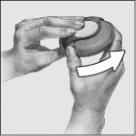
- Hold the device with the mouthpiece towards you. You can hold it with your right or left hand. Slide the lever away from you. You will hear a "click". This will place the dose of medicine in the mouthpiece.
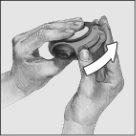
Each time the lever is pulled back, a blister is opened and the powder is prepared for inhalation. Do not play with the lever as the blisters will open and the medication will be wasted.
- Hold the Accuhaler away from your mouth. Breathe out as much as you can. Do not breathe into the Accuhaler.
- Place the mouthpiece in your lips; take a slow, steady breath in through the Accuhaler, not through your nose.
Take the Accuhaler out of your mouth.
Hold your breath for about 10 seconds or as long as you can.
Breathe out slowly.
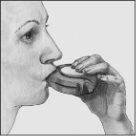
- Afterwards, rinse your mouth with water and spit it out and/or brush your teeth. This may help prevent mouth ulcers and hoarseness.
- To close the Accuhaler, slide the lever back towards you as far as it will go. You will hear a "click".
The lever will automatically return to its original position.
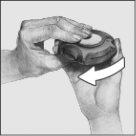
The Accuhaler is now ready to be used again.
As with all inhalers, caregivers should ensure that children using Anasma Accuhaler use the correct inhalation technique as described above.
Cleaning your inhaler
To clean it, wipe the mouthpiece of the Accuhaler with a dry cloth.
If you use more Anasma than you should
It is very important to use the inhaler as directed. If you accidentally take a higher dose than recommended, talk to your doctor or pharmacist. You may notice that your heart beats faster than normal and you may feel shaky. You may also feel dizzy, have a headache, feel weak, and have muscle pain.
If you have used high doses for long periods, you should ask your doctor or pharmacist for advice. This is because high levels of Anasma may reduce the amount of steroid hormones produced by the adrenal gland.
In case of overdose, consult your doctor or pharmacist immediately or call the Toxicology Information Service, phone: 91 562 04 20, indicating the medicine and the amount administered.
If you forget to use Anasma
Do not take a double dose to make up for forgotten doses. Take the next dose at the usual time.
If you stop using Anasma
It is very important that you use Anasma every day as directed. Keep taking it until your doctor tells you to stop. Do not stop using Anasma suddenly.This could make your breathing worse.
Also, if you stop taking Anasma suddenly or reduce the dose, you may (very rarely) get problems with your adrenal gland (adrenal insufficiency), which can sometimes cause side effects.
These side effects can include any of the following:
- Stomach pain.
- Tiredness and loss of appetite, feeling unwell.
- Abdominal pain and diarrhea.
- Weight loss.
- Headache or drowsiness.
- Low blood sugar levels.
- Low blood pressure and seizures (fits).
When your body is under stress, such as fever, injury (e.g., car accident), infection, or surgery, adrenal insufficiency can worsen and you may have any of the above side effects.
If you have any side effects, talk to your doctor or pharmacist. To prevent these symptoms, your doctor may prescribe you an additional dose of corticosteroids in tablets during that time (such as prednisolone).
If you have any further questions about the use of this medicine, ask your doctor, nurse, or pharmacist.
4. Possible side effects
Like all medicines, this medicine can cause side effects, although not everybody gets them. To reduce the occurrence of side effects, your doctor will prescribe the lowest dose of Anasma that controls your asthma or Chronic Obstructive Pulmonary Disease (COPD).
Allergic reactions: you may notice that your breathing suddenly gets worse immediately after using Anasma.You may wheeze and cough or feel short of breath. You may also notice itching, rash (hives), and swelling (usually of the face, lips, tongue, or throat). You may also feel your heart beating very fast, feel like you are going to pass out, and feel dizzy (which can lead to collapse or loss of consciousness). If you experience any of these effects or if they appear suddenly after using Anasma, stop taking Anasma and tell your doctor right away. Allergic reactions to Anasma are rare (affect less than 1 in 100 people).
Pneumonia (lung infection) in patients with COPD (common side effect)
Tell your doctorif you have any of the following symptoms while inhaling Anasma, they could be symptoms of a lung infection:
- Fever or chills
- Increased production of mucus, change in the color of mucus
- Increased coughing or increased difficulty breathing
The following side effects are also reported:
Very common (may affect more than 1 in 10 people)
- Headache, which usually improves as treatment continues.
- An increase in the number of colds has been reported in patients with Chronic Obstructive Pulmonary Disease (COPD).
Common (may affect less than 1 in 10 people)
- Oral thrush (itching, appearance of yellowish ulcers) in the mouth and throat. Also, pain in the tongue, hoarse voice, and throat irritation. Rinsing your mouth with water and spitting it out and/or brushing your teeth immediately after each dose of medicine may help. For the treatment of oral thrush, your doctor may prescribe antifungal medication (for the treatment of fungal infections).
- Pain, inflammation in the joints, and muscle pain.
- Muscle cramps.
The following side effects have been reported in patients with Chronic Obstructive Pulmonary Disease (COPD):
- Bruises and fractures.
- Sinusitis (feeling of tension or congestion in the nose, cheeks, and behind the eyes, sometimes with a pulsating pain).
- Decreased potassium levels in the blood (may feel irregular heartbeats, muscle weakness, cramps).
Uncommon (may affect less than 1 in 100 people)
- Increased blood sugar (glucose) levels (hyperglycemia). If you have diabetes, it will be necessary to monitor your blood sugar levels more frequently and adjust your usual diabetes treatment if necessary.
- Cataracts (clouding of the lens in the eye).
- Very fast heart rate (tachycardia).
- Feeling shaky and a fast or irregular heartbeat (palpitations). These side effects are usually harmless and decrease as treatment continues.
- Chest pain.
- Feeling anxious (occurs mainly in children).
- Sleep disorders.
- Rash.
- Allergic skin rash.
Rare (may affect less than 1 in 1,000 people)
- Difficulty breathing (or wheezing) that gets worse just after using Anasma. If this happens, stop using Anasma. Use your fast-acting "rescue" inhaler to improve your breathing and tell your doctor right away.
- Anasma may increase the normal production of steroid hormones, particularly if you have been taking high doses for long periods. The effects include:
- Delayed growth in children and adolescents.
- Decreased bone mineral density.
- Glaucoma.
- Weight gain.
- Round face (moon face) (Cushing's syndrome).
Your doctor will regularly monitor any of these side effects and ensure that you are taking the lowest dose of Anasma to control your asthma.
- Changes in behavior, such as hyperactivity and irritability (these effects occur mainly in children).
- Irregular heartbeats or extra heartbeats (arrhythmias). Talk to your doctor, but do not stop taking Anasma unless your doctor tells you to.
- Fungal infection in the esophagus (throat), which can cause difficulty swallowing.
Frequency not known, but may also occur:
- Depression or aggression. These effects are more likely to occur in children.
- Blurred vision
Reporting of side effects:
If you experience any side effects, talk to your doctor or pharmacist, even if it is possible side effects not listed in this leaflet. You can also report them directly through the Spanish Pharmacovigilance System for Human Use Medicines: www.notificaRAM.es. By reporting side effects, you can help provide more information on the safety of this medicine.
5. Storage of Anasma
Keep this medicine out of the sight and reach of children.
Do not use Anasma after the expiration date that appears on the label and on the carton after CAD. The expiration date is the last day of the month indicated.
Do not store at a temperature above 30°C.
Medicines should not be disposed of via wastewater or household waste. Deposit the packaging and any unused medicines at the SIGRE collection point in your pharmacy. If in doubt, ask your pharmacist how to dispose of the packaging and any unused medicines. This will help protect the environment.
6. Package Contents and Additional Information
Composition of Anasma
- Each pre-dispensed dose contains 50 micrograms of salmeterol (as salmeterol xinafoate) and 250 micrograms of fluticasone propionate.
- The other component is lactose monohydrate (contains milk proteins).
Appearance of the Product and Package Contents
Anasma Accuhaler contains a strip of blisters. The blisters protect the inhalation powder from atmospheric effects.
Each dose is pre-dispensed.
The devices are available in packages of 1 accuhaler x 60 inhalations.
Marketing Authorization Holder and Manufacturer
Marketing Authorization Holder:
GlaxoSmithKline, S.A.
P.T.M. C/ Severo Ochoa, 2
28760 Tres Cantos (Madrid)
Tel: +34 900 202 700
Manufacturer:
Glaxo Wellcome Production
Zone Industrielle nº 2, 23 Rue Lavoisier, La Madeleine, 27000 Evreux, France
Tel: + 33 2 3223 5500
Fax: +33 2 3223 5558
or
Aspen Bad Oldesloe GmbH
Industriestrasse 32-36, 23843 Bad Oldesloe, Germany
This leaflet was last revised in July 2020.
Detailed and up-to-date information on this medicine is available on the website of the Spanish Agency for Medicines and Health Products (AEMPS) http://www.aemps.gob.es/

How much does ANASMA ACCUHALER 50 micrograms/250 micrograms INHALATION, POWDER FOR INHALATION cost in Spain ( 2025)?
The average price of ANASMA ACCUHALER 50 micrograms/250 micrograms INHALATION, POWDER FOR INHALATION in December, 2025 is around 41.28 EUR. Prices may vary depending on the region, pharmacy, and whether a prescription is required. Always check with a local pharmacy or online source for the most accurate information.
- Country of registration
- Average pharmacy price41.28 EUR
- Active substance
- Prescription requiredYes
- Manufacturer
- This information is for reference only and does not constitute medical advice. Always consult a licensed doctor before taking any medication. Oladoctor is not responsible for medical decisions based on this content.
- Alternatives to ANASMA ACCUHALER 50 micrograms/250 micrograms INHALATION, POWDER FOR INHALATIONDosage form: PULMONARY INHALATION, 50 micrograms/250 microgramsActive substance: salmeterol and fluticasoneManufacturer: Sandoz Farmaceutica S.A.Prescription requiredDosage form: PULMONARY INHALATION, 50 micrograms/500 microgramsActive substance: salmeterol and fluticasoneManufacturer: Sandoz Farmaceutica S.A.Prescription requiredDosage form: PULMONARY INHALATION, 50 micrograms / 100 microgramsActive substance: salmeterol and fluticasoneManufacturer: Zentiva K.S.Prescription required
Alternatives to ANASMA ACCUHALER 50 micrograms/250 micrograms INHALATION, POWDER FOR INHALATION in other countries
The best alternatives with the same active ingredient and therapeutic effect.
Alternative to ANASMA ACCUHALER 50 micrograms/250 micrograms INHALATION, POWDER FOR INHALATION in Polonia
Alternative to ANASMA ACCUHALER 50 micrograms/250 micrograms INHALATION, POWDER FOR INHALATION in Ucrania
Online doctors for ANASMA ACCUHALER 50 micrograms/250 micrograms INHALATION, POWDER FOR INHALATION
Discuss dosage, side effects, interactions, contraindications, and prescription renewal for ANASMA ACCUHALER 50 micrograms/250 micrograms INHALATION, POWDER FOR INHALATION – subject to medical assessment and local rules.














